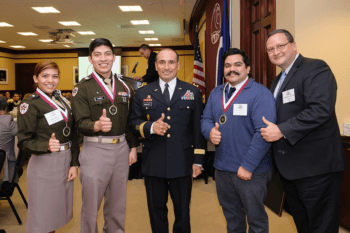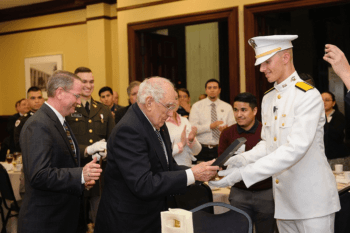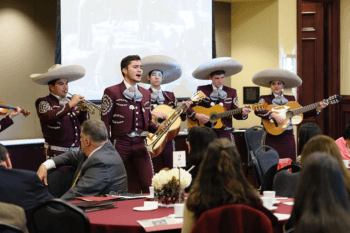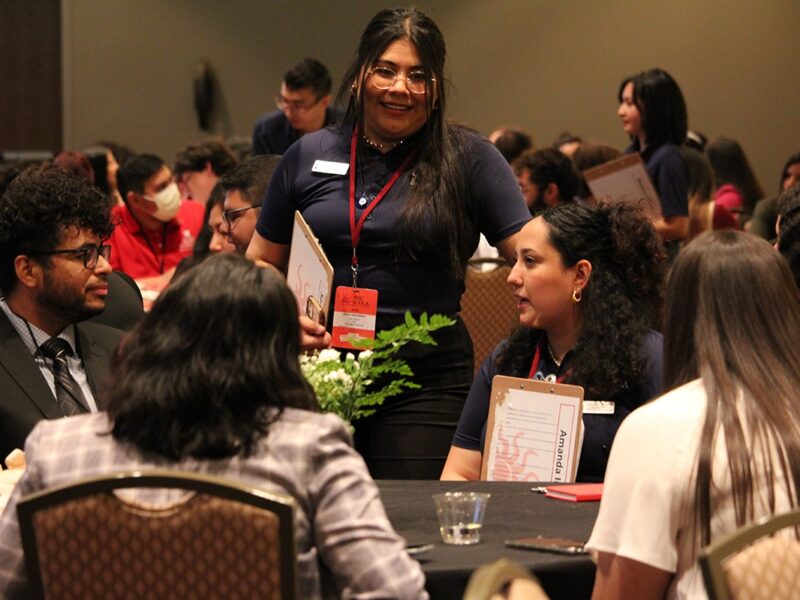Accomplishments, Challenges Noted At Texas A&M Hispanic Network Summit

Current and former Texas A&M University students joined with leaders from across the state to delve into issues affecting the Hispanic community at this year’s Hispanic Network (TAMHN) Summit at the Clayton Williams, Jr. Alumni Center on the Texas A&M campus.
Among a long list of notable presenters was Joe Pettibon, Texas A&M associate vice president for Academic Services, who said Hispanic enrollment on the main campus for fall 2014 was 10,355, accounting for 18.6 percent of the total campus population, a one-year growth of 12.1 percent (DARS). Pettibon said this improved yield is due to a combination of factors, including “faster offers, more campus visits, increased financial aid, and better coordination, especially with Prospective Student Centers.” He added the university strives to keep tuition and fees affordable and continues to rank highly in the Washington Monthly “Best Bang for the Buck” rankings in the Top 5 nationally in 2014.
The summit’s keynote speaker was former Texas A&M President Elsa Murano, who now serves as director of the Norman Borlaug Institute. She spoke of the university’s Core Values, chiefly, Selfless Service as it relates to the work of the Borlaug Institute. “In my role at Borlaug, I travel all over the world and especially to developing countries,” she said. “I’ve seen abject poverty…human beings that lack the basic necessities of clean water, food, security. Right now there are 800 million undernourished people; about 790 million are in Asia, Africa and Latin America.”
She spoke of the institute’s namesake Norman Borlaug, known as the Father of the Green Revolution, who spent the last decade of his life as a professor at Texas A&M. “He knew that peace cannot be built on empty stomachs,” she said.
Murano, a Cuban-American, came to the U.S. with her family as a toddler. “We departed our homeland in search of freedom,” she explained. “As a result I’ve become an American citizen by choice and live here in the greatest country on Earth.” On news of the U.S. possibly resuming relations with Cuba, Murano said, “We ache for our brothers and sisters who have lived through decades of tyranny. I long to return under the best circumstances, not the way it is there now. I hope for the best, but I want to make sure we make the best deal.”

Summit organizers recognized former student Renato Ramirez ’61, who graduated from Texas A&M with his bachelor’s in mechanical engineering and is currently the CEO of International Bank of Commerce in Zapata, Texas, for his outstanding contributions to the Hispanic community. Ramirez was named “Mr. South Texas 2014” for making significant and lasting contributions to the growth and development of Laredo and the South Texas region. In accepting the TAMHN’s recognition of his achievements, Ramirez told of his participation in the creation of the Tejano Monument, located in Austin on the grounds of the Capitol.
“In 2000, a group of six of us went to Austin and noted there was not one single work of art that reflected positively on Hispanics,” he recalled. Over the course of many years, Ramirez said, he and his group repeatedly met with state leaders and eventually were able to pay tribute to Tejano contributions to Texas history and culture with the monument. The life-sized sculptures featured depict the early Spanish pioneers who settled Texas. “Today, it is a very popular monument,” Ramirez noted.
Another presenter, Jose Bermudez, Texas A&M associate provost of strategic planning and professor of philosophy, spoke of the university’s Grand Challenges, including a focus on STEM (science, technology, engineering and mathematics) education. He noted that while Hispanics are now the majority in Texas public schools (TEA), 40 percent of Hispanics 25 and older have not completed high school – five times the figure for non-Hispanic whites. “We are speaking directly to those gaps,” Bermudez said, with programs such as the Texas Education Consortium for Male Students of Color and Center for Research and Development in Dual Language and Literacy Acquisition. “We are using the strategy of collective impact to make a dent in a statewide problem,” he noted.

Representing the Grand Challenge of One Health at the summit was Wesley Bissett, a professor in the College of Veterinary Medicine & Biomedical Sciences and director of the Veterinary Emergency Team (VET), a 38-member veterinary medical disaster response team. Bissett shared stories from the front line of veterinary emergency medicine, such as the team’s deployment to Bastrop, Texas, in 2011 to assist during the largest urban wildland fire in history. He said his experiences there served to reinforce the principle of One Health: humans, animals and the ecosystem are all mutually dependent on one another. He also noted a lack of diversity in veterinary medicine.
“Our lack of diversity puts our profession at risk,” he noted. “We are not as diverse as we’d like to be, but we are working on it. We need to get students of all cultures interested in vet medicine.”
The summit also included appearances by Brigadier General Joe E. Ramirez, Jr. ’79, commandant of the Corps of Cadets, WWII Veteran Capt. William Peña ’42 and the Aggieland Mariachi Club.
For more information about the Texas A&M Hispanic Network, visit www.aggienetwork.com/tamhn.
Media contact: Lesley Henton, Texas A&M Division of Marketing & Communications.





